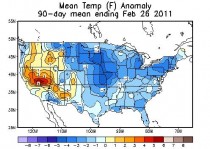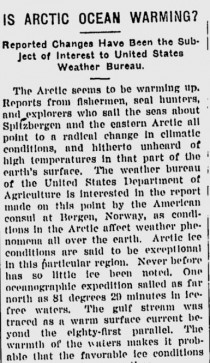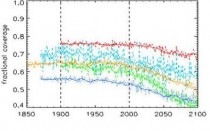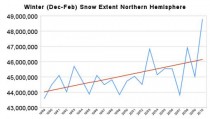By Marlo Lewis

Today, my friendly neighborhood Potbelly Sandwich Shop posted dozens of small flyers along the ordering line, asking: “Where are the tomatoes?” The flyer explained:
The recent cold weather across North America has had a severe impact on the availability, quality and cost of tomatoes.
Due to these factors, we will temporarily cease to offer tomatoes on your sandwhich. As soon as the tomato crop returns to normal we will add them back to your sandwiches.
We apologize for this inconvenience. We do not want to compromise on the quality or value of our sandwiches.
More evidence - if any were needed - that winter endangers public health and welfare. Tomatoes are a great source of anti-oxidents and other health-enhancing nutrients. And they are delish!
Besides ruining tomatoes, winter is strongly correlated with cold and flu. Winter can also cause or contribute to power outages, travel disruptions and delays, traffic accidents, and injuries from slipping on ice.
You’d think that by now global warming would have made harsh winter weather a thing of the past. Alas, no. Our tomatoes, and the health and welfare benefits they bring, are still endangered.
But be of good cheer. The carbon dioxide emissions allegedly responsible for Al Gore’s “planetary emergency” are helping tomatoes beef up. The Center for the Study of Carbon Dioxide and Global Change maintains a database on field and laboratory experiments measuring plant growth response to CO2-enriched environments. Here’s the link for data on tomatoes.
A whopping 45 studies have examined the effects of CO2 enrichment on the garden tomato (lycopersicon eculentum). On average, garden tomatoes gain 32.
See post.
Here is an approximate, preliminary look at the winter for the 90 days ending february 26, 2011. December/January was the coldest in Florida (winter vegetables) history and remember the frosts and freezes in California and south Texas.
By Roy W. Spencer, Ph. D.
The climate change deniers have no one but themselves to blame for last night’s vote.
I’m talking about those who deny NATURAL climate change. Like Al Gore, John Holdren, and everyone else who thinks climate change was only invented since they were born.
Politicians formed the IPCC over 20 years ago with an endgame in mind: to regulate CO2 emissions. I know, because I witnessed some of the behind-the-scenes planning. It is not a scientific organization. It was organized to use the government-funded scientific research establishment to achieve policy goals.
Now, that’s not necessarily a bad thing. But when they are portrayed as representing unbiased science, that IS a bad thing. If anthropogenic global warming - and ocean ‘acidification’ (now there’s a biased and totally incorrect term) - ends up being largely a false alarm, those who have run the IPCC are out of a job. More on that later.
I don’t want to be misunderstood on this. IF we are destroying the planet with our fossil fuel burning, then something SHOULD be done about it.
But the climate science community has allowed itself to be used on this issue, and as a result, politicians, activists, and the media have successfully portrayed the biased science as settled.
They apparently do not realize that ‘settled science’ is an oxymoron.
The most vocal climate scientists defending the IPCC have lost their objectivity. Yes, they have what I consider to be a plausible theory. But they actively suppress evidence to the contrary, for instance attempts to study natural explanations for recent warming.
That’s one reason why the public was so outraged about the ClimateGate e-mails. ClimateGate doesn’t prove their science is wrong...but it does reveal their bias. Science progresses by investigating alternative explanations for things. Long ago, the IPCC all but abandoned that search.
Oh, they have noted (correctly I believe) that a change in the total output of the sun is not to blame. But there are SO many other possibilities, and all they do is dismiss those possibilities out of hand. They have a theory - more CO2 is to blame - and they religiously stick to it. It guides all of the research they do.
The climate models are indeed great accomplishments. It’s what they are being used for that is suspect. A total of 23 models cover a wide range of warming estimates for our future, and yet there is no way to test them for what they are being used for! climate change predictions.
Virtually all of the models produce decadal time scale warming that exceeds what we have observed in the last 15 years. That fact has been known for years, but its publication in the peer reviewed literature continues to be blocked.
My theory is that a natural change in cloud cover has caused most of the recent warming. Temperature proxy data from around the world suggests that just about every century in the last 2,000 years has experienced warming or cooling. Why should today’s warmth be manmade, when the Medieval Warm Period was not? Just because we finally have one potential explanation - CO2?
This only shows how LITTLE we understand about climate change...not how MUCH we know.
Why would scientists allow themselves to be used in this way? When I have pressed them on the science over the years, they all retreat to the position that getting away from fossil fuels is the ‘right thing to do anyway’.
In other words, they have let their worldviews, their politics, their economic understanding (or lack thereof) affect their scientific judgment. I am ashamed for our scientific discipline and embarrassed by their behavior.
Is it any wonder that scientists have such a bad reputation among the taxpayers who pay them to play in their ivory tower sandboxes? They can make gloom and doom predictions all day long of events far in the future without ever having to suffer any consequences of being wrong.
The perpetual supply of climate change research money also biases them. Everyone in my business knows that as long as manmade climate change remains a serious threat, the money will continue to flow, and climate programs will continue to grow.
Now, I do agree the supply of fossil fuels is not endless. But we will never actually “run out”...we will just slowly stop trying to extract them as they become increasingly scarce (translation - more expensive). That’s the way the world works.
People who claim we are going to wake up one morning and our fossil fuels will be gone are either pandering, or stupid, or both.
But how you transition from fossil fuels to other sources of energy makes all the difference in the world. Making our most abundant and affordable sources of energy artificially more expensive with laws and regulations will end up killing millions of people.
And that’s why I speak out. Poverty kills. Those who argue otherwise from their positions of fossil-fueled health and wealth are like spoiled children.
The truly objective scientist should be asking whether MORE, not less, atmospheric carbon dioxide is what we should be trying to achieve. There is more published real-world evidence for the benefits of more carbon dioxide, than for any damage caused by it. The benefits have been measured, and are real-world. The risks still remain theoretical.
Carbon dioxide is necessary for life on Earth. That it has been so successfully demonized with so little hard evidence is truly a testament to the scientific illiteracy of modern society. If humans were destroying CO2 - rather than creating more - imagine the outrage there would be at THAT!
I would love the opportunity to cross examine these (natural) climate change deniers in a court of law. They have gotten away with too much, for too long. Might they be right? Sure. But the public has no idea how flimsy - and circumstantial - their evidence is.
In the end, I doubt the IPCC will ever be defunded. Last night’s vote in the House is just a warning shot across the bow. But unless the IPCC starts to change its ways, it runs the risk of being totally marginalized. It has almost reached that point, anyway.
And maybe the IPCC leadership doesn’t really care if its pronouncements are ignored, as long as they can jet around the world to meet in exotic destinations and plan where their next meeting should be held. I hear it’s a pretty good gig.
The Local
Following another extended stretch of sub-zero temperatures, ice coverage on the Baltic Sea is greater than it’s been in nearly a quarter century, Sweden’s meteorological agency reports.
About 250,000 square kilometres of the Baltic Sea are now covered in ice according to the Swedish Meteorological and Hydrological Institute (SMHI).
The last time so much of the Baltic was frozen was the winter of 1986-87, when ice covered nearly 400,000 square kilometres of the sea’s surface.
SMHI warns that ice coverage on the Baltic could expand further in the coming days, possibly setting a new record.
“The surface water is cold and if winter-like temperatures continue in the region a few more weeks, we’ll probably get an icy winter on par with 1984-85, one of the toughest winters in the 1980s,” SMHI oceanographer Amund E. B. Lindberg said in a statement.
According to SMHI’s estimates, ice may eventually connect the Swedish mainland all the way out to the Baltic island of Gotland, which lies about 90 kilometres off of Sweden’s eastern coast.
Baltic ice cover is not only unusually wide this winter, but also unusually thick, especially in Gulf of Bothnia off Sweden’s northeastern coast, where air temperatures have consistently hovered around -30 degrees Celsius in recent months.
In some areas far out at sea, ice is more than 60 centimetres thick in the northern parts of the gulf.
Recent cold temperatures near the southern areas of the Gulf of Bothnia have resulted in ice thickness growing by 30 centimetres in just two weeks.
Icebreakers from the Swedish Maritime Administration (Sjöfartsverket) have been working round the clock to ensure that sea routes on the Baltic remain open, but strong winds expected at the weekend may complicate their work.
“For the moment, sea traffic is flowing nicely,” Ulf Gullne, head of the Maritime Administration’s icebreaker unit, to the TT news agency.
“But if storms kick up, there are always problems because the ice begins to crumble and that creates banks.”
By Ross R. McKitrick
Prepared for Workshop on “Reconciliation in the Climate Change Debate” at the Institute for the Protection and Security of the Citizen, European Commission, Lisbon, Portugal, January 26-28, 2011
1. Introduction
I am an “outsider” to the field of climatology in two respects: by professional training I am an economist, and as regards my research I am in dispute with proponents of some elements of what is commonly called the “consensus” scientific position. With regards to my economics background, I note that economists routinely undertake scientific research on matters of acute political controversy, yet the field remains generally congenial and productive; whereas the policy controversies connected to climate research have resulted in seriously disrupted and damaged collegiality in climatology. Why the difference between the two fields? I suggest attention be paid to two reasons: the habit on the part of climate and meteorological societies to issue “expert statements” on behalf of members, and the role of the IPCC.
2. The Key to Intellectual Freedom in Economics: No Society Statements
I am a member of the American and Canadian Economic Associations. The AEA Constitution commits it to (emphasis added): The encouragement of perfect freedom of economic discussion. The Association as such will take no partisan attitude, nor will it commit its members to any position on practical economic questions.
Likewise the CEA constitution forbids issuing statements: The Association has for its object the advancement of economic knowledge through the encouragement of study and research… and the furtherance of free and informed discussion of economic questions. The Association as such will not assume a partisan position upon any question of practical politics nor commit its members to any position thereupon.
Economists believe that freedom of discussion requires a prohibition on our major societies issuing position statements. There is wisdom in this! Individual experts can speak for themselves if they desire. Official “society” statements put words in peoples’ mouths, imposing groupthink and conformity and
fostering bitterness on the part of those who find themselves with no voice. They silence and marginalize members who disagree with some or all of the statement, demoting them to second-class citizens in their own profession, regardless of their numbers or credibility as scientists.
Official statements replace the slow process of winnowing scientific truth by promoting a political “appeal to authority.” It encourages journalists, policymakers, educators and others to rest their case on the “Expert Statement” rather than on the evidence. Consequently, public debate becomes less
informative, and more authoritarian.
Climatology will not regain collegiality and freedom of discussion, and will continue to suffer factionalism and alienation, until its scientific societies do as economics societies do and forbid issuing position statements on members’ behalf.
Read more and see how the IPCC plays a role in the full talk.
ICECAP NOTE: Having been a councilor when the AMS produced their statement on climate change, I observed how groupthink and vested interests in propagating the consensus position on the the part of the committee drafting the report and the fact that the 11,000 members did not get to vote on this. Yet the impression left on the journalists and other sciences was that there was unanimity on the issues among atmospheric scientists which is clearly not the case as subsequent internal surveys among broadcasters and informal surveys of CCMs later showed. The economists may have just as much trouble predicting the future, but they have this process right.
By Anthony Watts
First some background for our readers that may not be familiar with the term “random walk” (See).
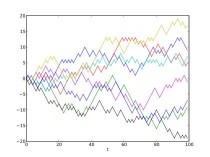
From Wikipedia: Example of eight random walks in one dimension starting at 0. The plot shows the current position on the line (vertical axis) versus the time steps (horizontal axis).
--------
By Roger Pielke Sr., Climate Science
New Paper “Random Walk Lengths Of About 30 Years In Global Climate” By Bye Et Al 2011
There is a new paper [h/t to Ryan Maue and Anthony Watts] titled
Bye, J., K. Fraedrich, E. Kirk, S. Schubert, and X. Zhu (2011), Random walk lengths of about 30 years in global climate, Geophys. Res. Lett., doi:10.1029/2010GL046333, in press. (accepted 7 February 2011)
The abstract reads:
“We have applied the relation for the mean of the expected values of the maximum excursion in a bounded random walk to estimate the random walk length from time series of eight independent global mean quantities (temperature maximum, summer lag, temperature minimum and winter lag over the land and in the ocean) derived from the NCEP twentieth century reanalysis (V2) (1871-2008) and the ECHAM5 IPCC AR4 twentieth century run for 1860-2100, and also the Millenium 3100 yr control run mil01, which was segmented into records of specified period. The results for NCEP, ECHAM5 and mil01 (mean of thirty 100 yr segments) are very similar and indicate a random walk length on land of 24 yr and over the ocean of 20 yr. Using three 1000 yr segments from mil01, the random walk lengths increased to 37 yr on land and 33 yr over the ocean. This result indicates that the shorter records may not totally capture the random variability of climate relevant on the time scale of civilizations, for which the random walk length is likely to be about 30 years. For this random walk length, the observed standard deviations of maximum temperature and minimum temperature yield respective expected maximum excursions on land of 1.4 and 0.5 C and over the ocean of 2.3 and 0.7 C, which are substantial fractions of the global warming signal.”
The text starts with:
“The annual cycle is the largest climate signal, however its variability has often been overlooked as a climate diagnostic, even though global climate has received intensive study in recent times, e.g. IPCC (2007), with a primary aim of accurate prediction under global warming.”
We agree with the authors of the paper on this statement. This is one of the reasons we completed the paper:
Herman, B.M. M.A. Brunke, R.A. Pielke Sr., J.R. Christy, and R.T. McNider, 2010: Global and hemispheric lower tropospheric temperature trends. Remote Sensing, 2, 2561-2570; doi:10.3390/rs2112561
where our abstract reads:
“Previous analyses of the Earth’s annual cycle and its trends have utilized surface temperature data sets. Here we introduce a new analysis of the global and hemispheric annual cycle using a satellite remote sensing derived data set during the period 1979–2009, as determined from the lower tropospheric (LT) channel of the MSU satellite. While the surface annual cycle is tied directly to the heating and cooling of the land areas, the tropospheric annual cycle involves additionally the gain or loss of heat between the surface and atmosphere. The peak in the global tropospheric temperature in the 30 year period occurs on 10 July and the minimum on 9 February in response to the larger land mass in the Northern Hemisphere. The actual dates of the hemispheric maxima and minima are a complex function of many variables which can change from year to year thereby altering these dates.
Here we examine the time of occurrence of the global and hemispheric maxima and minima lower tropospheric temperatures, the values of the annual maxima and minima, and the slopes and significance of the changes in these metrics. The statistically significant trends are all relatively small. The values of the global annual maximum and minimum showed a small, but significant trend. Northern and Southern Hemisphere maxima and minima show a slight trend toward occurring later in the year. Most recent analyses of trends in the global annual cycle using observed surface data have indicated a trend toward earlier maxima and minima.”
The 2011 Bye et al GRL paper conclusion reads:
“In 1935, the International Meteorological Organisation confirmed that ‘climate is the average weather’ and adopted the years 1901-1930 as the ‘climate normal period’. Subsequently a period of thirty years has been retained as the classical period of averaging (IPCC 2007). Our analysis suggests that this administrative decision was an inspired guess. Random walks of length about 30 years within natural variability are an ‘inconvenient truth’ which must be taken into account in the global warming debate. This is particularly true when the causes of trends in the temperature record are under consideration.”
This paper is yet another significant contribution that raises further issues on the use of multi-decadal linear surface temperature trends to diagnose climate change. Post.
By Steven Goddard
According to US Navy PIPS2 maps, the area of thick Arctic ice has more than doubled, and the volume of Arctic ice has increased by 26% - since 2008. You can see from the graph below that ice thickness distribution has shifted dramatically to the right since the same date in 2008 (below, enlarged).
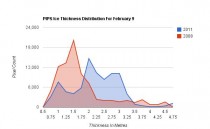
You can also see why NSIDC only likes to talk about 4+ year old ice. The reason being that it will take another two years to recover from the 2007 low.
The blink comparator below shows growth of ice greater than 2.5 metres thick.
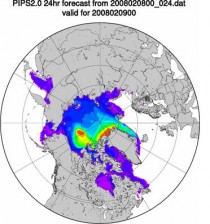
February 8, 2008 (NRLSSC Navy) http://www7320.nrlssc.navy.mil/
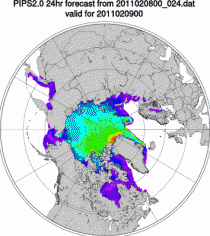
February 8, 2011 (NRLSSC Navy)
------
1923 Shock News: Arctic Melting - “radical change in climatic conditions”
Glaciers disappearing! Least ice ever recorded! Great changes to flora and fauna!
Dr Roy Spencer
Roy in this post nails it. Steve Milloy had a similar million dollar challenge on his web site. There were no winners. Dr Economides of the University of Houston offerd $10,000 to his students if they could find a paper that from first principles, how CO2 was causing catastrophic global warming. Again for many years no students have won. Here is Roy’s challenge:
I’ve been picking up a lot of chatter in the last few days about the ‘settled science’ of global warming. What most people don’t realize is that the vast majority of published research on the topic simply assumes that warming is manmade. It in no way “proves” it.
If the science really is that settled, then this challenge should be easy:
Show me one peer-reviewed paper that has ruled out natural, internal climate cycles as the cause of most of the recent warming in the thermometer record.
Studies that have suggested that an increase in the total output of the sun cannot be blamed, do not count...the sun is an external driver. I’m talking about natural, internal variability.
The fact is that the ‘null hypothesis’ of global warming has never been rejected: That natural climate variability can explain everything we see in the climate system.
Investor’s Business Daily
As it snows for the third year in a row in Houston and the central and northeast dig out from the latest snow and ice storm, Al Gore emerges from his hole fittingly on Ground Hogs Day to proclaim he and his ‘scientists’ expected this (although in his movie just like the IPCC and NOAA CCSP reports, he warned snow would retreat north and winter cold would be history). Excerpts from the IBD editorial:
Hoaxes: As the nation digs itself out, the grand wizard of global warming comes out of hiding and blames it all on that SUV stuck in your driveway. A blizzard is a terrible thing to waste.
What has been dubbed the Groundhog Day Blizzard has caused Al Gore to poke his head out of his massive carbon-generating mansion in Nashville, Tenn., to blame the 2,000-mile storm on our alleged obsession with fossil fuels.
Sorry, Al, but in Chicago the solar panels were buried under upward of two feet of snow as citizens cranked up those polluting snow blowers, a scene repeated in much of the country. In the middle of blowing snow, blowing smoke does not help. Get our drift?
Fox News icon Bill O’Reilly recently asked rhetorically, “Why has southern New York turned into the tundra?” He said he’d left a message for Gore. Gore replied on his blog Tuesday that “scientists have been warning for at least two decades that global warming could make snowstorms more severe” and that what we are shoveling is a result of “increased evaporation meeting the cold air of winter.”
Gore has been relatively quiet in recent months as the hot air of his theories met the cold logic of observable fact. Earth has demonstrably cooled in the past decade as the sun and its solar cycle grew quiet.
...
In 2007, Sen. Barbara Boxer, D-Calif., warned that we wouldn’t have enough snow and that “the most optimistic climate models for the second half of this century suggest that 30% to 70% of the snow pack will disappear.” In 2009, Boxer warned: “Looking at the United States of America, the IPCC clearly warned that unchecked global warming will lead to reduced snow pack in the Western mountains, critically reducing access to water, which is our lifeblood.”
Reduced snow? On the Senate floor on March 31, 2002, Sen. Robert Byrd said the lack of snow that winter in the nation’s capital showed the need to do something about global warming. California Sen. Dianne Feinstein in 2005 said of Sierra Nevada white stuff: “By the end of the century, the shrinking of the snow pack will eliminate the water source for 16 million people.”
Too much snow, too little snow, floods and droughts, all caused by global warming, er, climate change. Al Gore and friends have been doing a lot of shoveling, but it hasn’t been the white stuff.
------------
On the Snow Job
By Roger Cohen
Stimulated by the claims by Gore and his acolytes that the recent snowstorm is due to (fanfare) global warming, I dug up this item from three years ago, almost to the day. You may not be aware that there is a bit of a flap in the UK about that the government knew or suppressed about forecasts for a severe winter this year, which it has been.
But what about us? And what about the climate models that we rely on to project future temperatures, and on which all proposed policies are based? What did they say, and when did they say it?
There is a lot of stuff around like this Columbia University review paper from which says snow cover in North America should decrease. The paper shows a range of model projections of NA snow cover, “using nine general circulation models (GCMs) of the global atmosphere-ocean system participating in the upcoming Intergovernmental Panel on Climate Change Fourth Assessment Report (IPCC-AR4)...” (the report ultimately published in 2007).
This graph gives the range of predictions from the models. The plot is percent coverage of the North American continent against year. The range of model predictions is large, but they show a downward trend beginning around 1990, which at least makes sense if the world is going to warm.
Some models show a discernible decrease for the period 1990-2010+:
The actual snow cover data trend (per Rutgers data) shows an increasing trend instead of the predicted decrease.
The point is that rather than make ridiculous claims about a single weather event to motivate a political agenda, one needs to look at the trends. As is almost always the case with the global warmists, what they say and what the real data show are in stark contradiction.
I send this from sunny Tucson, AZ where there is no snow, though the low was 16 deg F and the expected high will be 38. Just cold weather.
--------
The Emperor is being exposed more and more every day. Here is Al Gore carrying his book.
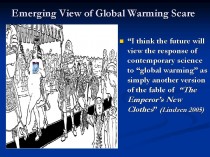
And this from Josh posting on Bishop Hill of Kevin Trenberth.
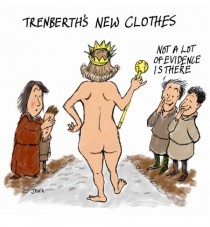
Minnesotans for Global Warming new video:
Their epic ‘If We Had Some Global Warming’ video
See their M4GW Youtube site with an excellent collection of videos. DVDs are available. Note: New video coming soon.
See comic songster Ray Steven’s take on Global warming here.
See this story in the Cypress Time ENVIROCLOWNS MASQUERADING AS CLIMATE SCIENTISTS by Tony Elliott.





